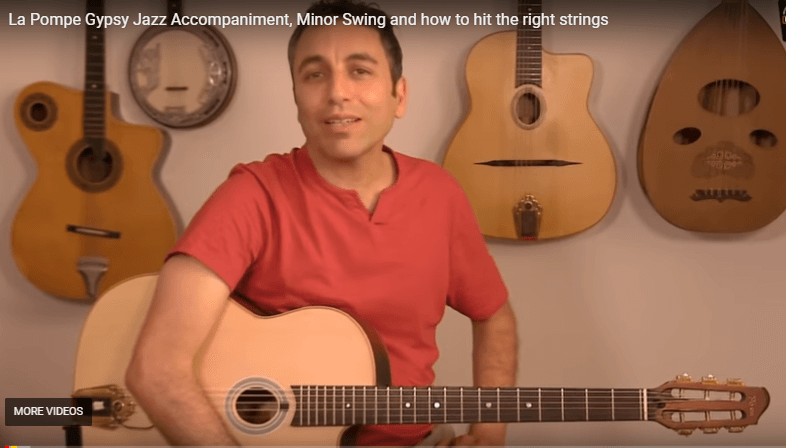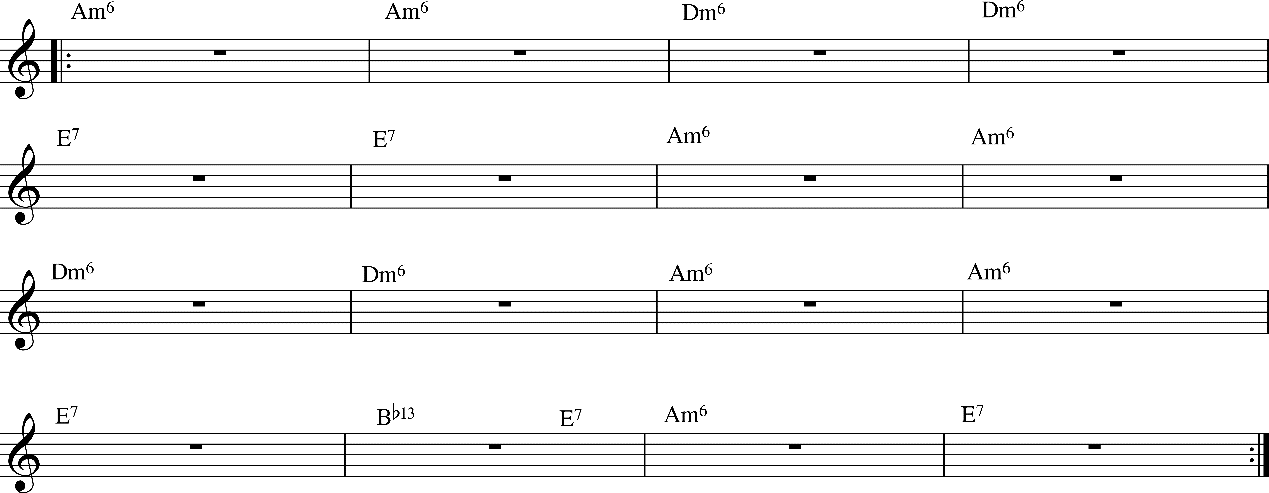
In this lesson, I will talk about the Gypsy Jazz accompaniment, La Pompe, and about a very important and interesting question I got from one of the students of my La Pompe course.
She has noticed that she is hitting the bottom E, 6th string, while trying to play the chords with the root on the 5th or the 4th string.
So let’s talk about how to hit ONLY the strings you want when playing La Pompe.
But first, let’s have a quick review to make sure we’re on the same track.
We have two main La Pompe types:
Traditional La Pompe and Downstroke La Pompe.
They both share the same two downstrokes: It’s good to start when the first one is short. And the second one even shorter. Notice that In the next example I marked the slap as muted, but you should play it almost muted, but still with a pitch.

When you play slowly, make sure your elbow moves and not only the wrist and that your wrist is slightly bent.
In the first downstroke – don’t involve your wrist.
In the second downstroke – use your wrist like a whip.
In both movements, use the right side of the nail of your index finger along with your pick.
Hit all the strings with each downstroke.
Traditional La Pompe

To fully understand the traditional La Pompe, I break it down into eight steps in my full La Pompe course. But to make it easier here, let’s concentrate on only two steps.
Step 1:
Precede the first downstroke with an upstroke, and follow it with a quick jump of your right hand towards the upper part of your guitar body, so that you finish this movement with your right hand up, close to the upper part of your guitar body.
Emphasize the sound of the lower strings more than the sound of the upper strings
Step 2:
Play the same “slap” we played in the downstroke La Pompe. Emphasize the sound of the upper strings more than the sound of the lower strings.
Here is a checklist for you to make sure you remember all the aspects of technique we’ve discussed:
- Use your elbow.
- Your wrist should be slightly bent.
- In the first downstroke – don’t involve your wrist.
- In the second downstroke – add your wrist to create a whip like slap.
- Perform a quick jump up at the end of the first downstroke.
- In both movements, use the right side of the nail of your index finger along with your pick.
- Hit all the strings.
- Freeze after each movement. Don’t make unnecessary movements.
Now that we have the basics – lets see how we adjust our right hand not to hit unwanted strings.
First let’s add three nice chord progressions, with a different bass root to each one of them:
Am – progression with the root on the 6th string:

Dm – progression with the root on the 5th string:

Am – progression with the root on the 4th string:

When you don’t want to hit the 6th string, or the 5th and 6th strings, adjust the angle of your wrist, so when you want to omit the 6th string, it’s just not in the direction of your right hand and your movement just won’t touch the 6th string. It’s like hitting the strings from the side.
Basic suggested chord progression for Minor Swing:

I hope you’ve found this lesson helpful and I’d love to read your comments here below.
If you want more, if you want to master your La Pompe and learn everything you need about it including learning a basic Gypsy Jazz repertoire with my special Guitar Mastery tracks, check out the full course here-

Sam Marchesan
Fantastic. All your content is clear and to the point. Thanks
Aleksandar
Thx for the video , can you just tell us quickly how to hold a pick for gypsy jazz. Thank you !
Yaakov Hoter
Please see the pictures. It’s about 90 degrees for the pick. 45 degrees for the hand. But don’t think about degrees. Get the general direction and the fine tuning is individual.

Robert Van Den Enden
Dear Yaakov . Robbie i appreciate these lessons but must say some of the information I am confused by..In your La pompe course you stress to always hit all the strings . Here you you say adjust your wrist angle so as not to hit certain strings.. I understand if you need to mute certain strings that you don’t want to sound you use maybe your thumb or fore finger or whatever so certain strings don;t ring.To me you cant hit all the all the strings and then not hit them all at the same time. obviously i think you hit them all and mute unwanted tones by various means where possible but if you cant mute those strings you don’t want to be hitting those darn strings.. please do not take me to seriously because i certainly don’t. but you definately cannot strike all the strings and then not strike them at the same time.
Yaakov Hoter
Hi Robert
There are more than one way to play La Pompe
In the course I teach the basic one you MUST have
But people are asking – how can I hit all the strings if I have unwanted strings?
So this video, as you understood, gives the answer to that
Of course you can’t do them together